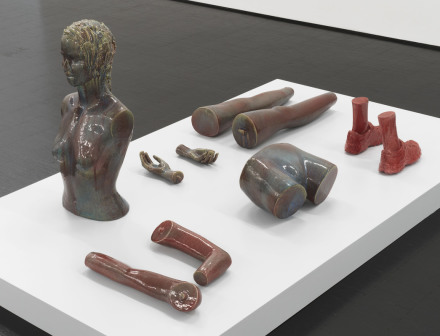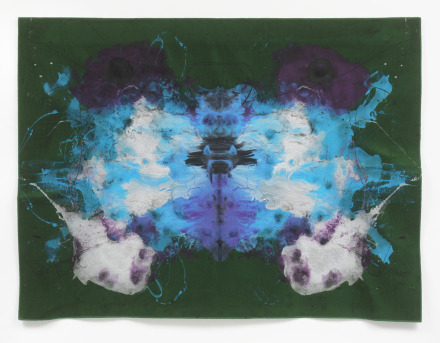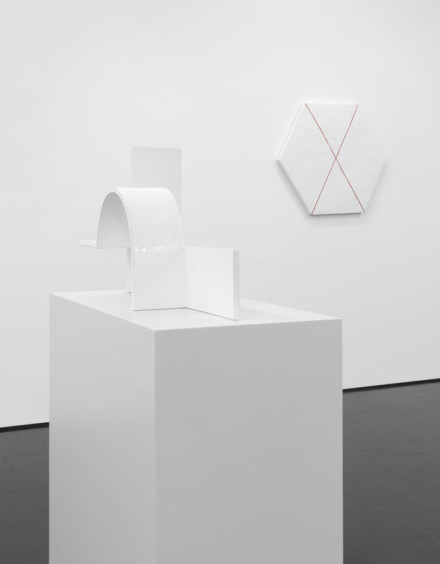
Mai-Thu Perret, Agua Viva (Installation View), via Galerie Barbara Weiss
Currently on at Galerie Barbara Weiss in Berlin, artist Mai-Thu Perret has opened an exhibition of new works drawing on a range of conceptual vectors to explore modernity in conversation with a range of disparate timelines and frames of reference. Drawing its title from writer Clarice Lispector’s book of the same name, the work seems to explore a similar exploration of time as atomic, as suspended along a series of varied singularities that converge and break apart, each moment a collision of varied possibilities and probabilities.

Mai-Thu Perret, Agua Viva (Installation View), via Galerie Barbara Weiss
Perret’s work here explores a range of disembodied elements and pieces, breaking apart bodies, contexts and easy reference systems in pursuit of a distinct sense of ambiguity and exploration. In her own way, Perret’s show tries to access the contemporary moment, not by possessing or holding the instant, however, but by exploring the non-coincidence of the present with itself, its latencies and anachronisms, exploring a sort of archaeology of modernism, but one that is less interested in death or decay, critique or proposition. Instead, her works are bound up in a continuum that seems to absorb and reframe each element in time. The show makes reference in particular to The Crystal Frontier, a fictional narrative around the actions of a group of feminist militants that exiled themselves from patriarchal society to found an utopian community. This body of work has guided much of Perret’s own practice, and here takes on a new expression.

Mai-Thu Perret, Agua Viva (Installation View), via Galerie Barbara Weiss

Mai-Thu Perret, Agua Viva (Installation View), via Galerie Barbara Weiss
In one corner, this effort takes the shape of a series of disassembled pieces of a woman’s body; hands, legs, feet, torsos all arranged in a grid and evoking a sort of bodily abstraction as much as it recalls the classical history of sculpture. Perret presents the body in both its classical, essentialist technique of depiction, and in a sort of modernist taxonomy, reducing the body to the sum of its parts and destroying a sense of cohesion. In its disfigured state and insistent physicality, it bears witness to the vulnerability of the human body in the face of disaster. Rather than signifying the commodification of the body, the mannequin thereby turns into an emblem for the exigencies confronting feminist art and politics in the present, a time of rupture that is mirrored in the reformatting and re-construction of the human form.

Mai-Thu Perret, Agua Viva (Installation View), via Galerie Barbara Weiss
In contrast, the artist also presents ceramic turtle sculptures, breaking out from the human symbol systems present nearby, but nevertheless recalling the narrative of modernist natural science, namely Darwin and his interest in the creatures of the Galapagos. Evolution is introduced as a parallel frame here, but nevertheless one that carries substantial conceptual weight and a sense of conversation across timeframes and systems of meaning. In a similar vein, two rug paintings with Rorschach test patterns allude to the Modernist exploration of the unconscious and contingency on the most decorative of mediums. Taken together, Perret’s constellation is untimely modernist, science-fiction, desperately utopian, urgently contemporary, each time posing questions of orientation and perspective, understanding and empathy, all suspended within a network of objects that the viewer must work through and around.
Both a marginal, fragmentary archaeology and an archaeology of the marginal and fragmentary, the exhibition traces counter-narratives through the historicity of singular objects. It closes November 9th.
— D. Creahan
Read more:
Mai-Thu Perret: Agua Viva [Exhibition Page]



